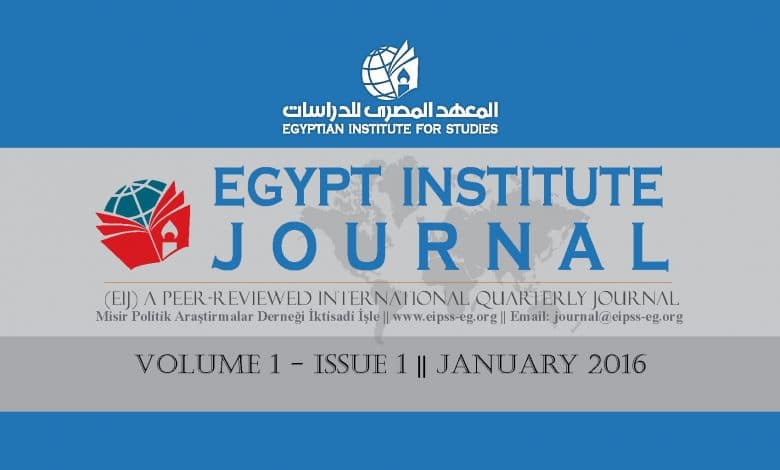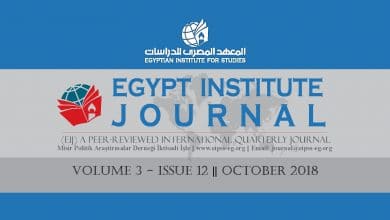
Egypt Institute Journal (Vol. 1 – Issue 1)
Introduction
Issue No. 1 of the Egypt Institute Journal, published in January 2016, included a number of political, strategic, economic, intellectual and legal articles, as follows:
1- ‘Democracy and Democratic Transformation: Theoretical and Rooting Dimensions’, by Iman Ahmed Abdel Halim
The study addresses the distinction between the concept of democracy and democratic transformation. In her endeavor to build a procedural definition of democracy, the researcher concludes that there are three dimensions in definition of the term, namely:
a- Competition between multiple parties over power, where positions change periodically so that one party does not monopolize power, allowing easy peaceful transfer of power, without resorting to the use of force.
b- Political participation through the right to vote guaranteed for adult citizens, enabling them to choose leaders and replace them with others through periodic and fair elections.
c- Civil and political freedoms are guaranteed to citizens, such as freedom of belief, freedom of assembly, freedom of expression, freedom to form parties and organizations and freedom to join them, in addition to freedom of access to information, and freedom of the press.
2- ‘Peace Building in Post-revolutionary Systems, the Case of Egypt’, by Mai Ghaith
The study covers several axes, namely:
First, Societal cohesion: concept and indicators
Second, Peace building: concept, steps, and procedures
Third, Impact of the revolution on social cohesion in Egypt
Fourth and last, Mechanisms for peace building and enhancing internal cohesion in Egypt
3- Israeli Policy Toward the Islamic State, by Dr. Adnan Abu Amer
The study is based on the descriptive analytical approach and attempts to answer the following questions:
– Why did the rise of the Islamic State gain exceptional importance with Israel?
– How did Israel consider the significance and seriousness of the rise of the Islamic State, and what is its impact on both sides?
– How did Israel manage to exploit the successive regional developments towards the organization in serving its strategic interests?
4- ‘Hamas and the Salafi Movement in the Gaza Strip, Reality and Prospects’, by Mohamed Abu Saada
The study to answer a fundamental question, namely, ‘What is the nature and future of the relationship between the Salafi Jihadist movement in Gaza and the Palestinian Hamas movement?’. The writer relies on the comparative historical analytical approach in his study.
5- ‘The Egyptian Role in Libya: Determinants and Dimensions’, by Dr. Essam Abdel Shafy
The study is divided into three axes, namely:
– The first axis addresses the situation inside the Libyan interior,
– The second axis addresses the dimensions of the role of the Egyptian military coup in Libya,
– The third axis addresses the factors governing the future of the coup in Libya.
6- ‘The Right to Appeal Criminal Provisions in Contemporary Judicial Systems, the Case of Egypt’, by Dr. Khaled El-Sayed Metwally
The study concludes that the Egyptian Penal Code used to allow appeals against verdicts issued in felonies, but this system was abolished, which made these verdicts became final once issued, pursuant to the provisions of the Penal Code No. 150 of September 3, 1950, which derives the provisions for appeal at the Court of Appeals from French legislation, bearing in mind that the French legislator made a legislative amendment on June 15, 2000, allowing appealing against felony verdicts – for conviction judgments.
To Read Text in PDF Format Click here.



